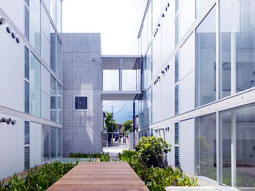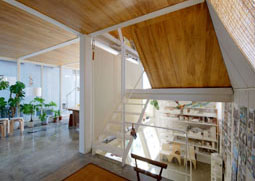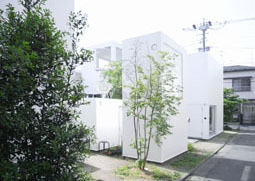 |
|
 |
The juxtaposition of open and closed spaces in Koh Kitayama's Yutenji Apartments (Meguro ward) is a study in restoring a relational context to city living, whereby residents and their neighborhoods are no longer isolated. The exhibition recreates the work in 1:20 scale.
Yutenji Apartments by Koh Kitayama; 2010 © Architecture Workshop; photo by Daici Ano |
Tokyo's constant flux, its organic ability to change appearance seemingly overnight, has intrigued and vexed visitors and residents alike since the city's earliest days. This perpetual cycle of destruction and renewal inspired the radical Metabolist movement led by prominent Japanese architects in the 1960s, now revisited -- from a humanist perspective -- in house inside city outside house -- Tokyo Metabolizing at Tokyo Opera City Art Gallery.
An expanded version of the Japan Pavilion presentation curated by Koh Kitayama at last year's Venice Biennale, the show is a collaborative effort by Kitayama, Yoshiharu Tsukamoto and Momoyo Kaijima of Atelier Bow-Wow, and Ryue Nishizawa. They posit that if a home is a reflection of the dreams and aspirations of its occupants, then it is the unsung residential areas rather than the skyscrapers and megadevelopments of the commercial sphere that give a city its distinctive energy, and where we are most likely to find hints of its future.
Via filmic and photographic essays and large-scale models of their recent works, the architects examine Tokyo's urban image from both practical and theoretical standpoints, and in so doing make much sense out of its chaotic messiness. In particular, their typology of site contexts and development patterns is so fittingly persuasive that you may find yourself applying these models to the streetscapes you pass on the way home, reading familiar scenes in a new light.
 |
|
 |
In the densely built neighborhood of Sugacho between Shinjuku and Yotsuya, Atelier Bow-Wow's "House & Atelier" combines the architect couple's living quarters and workspaces under one roof, gently demarcating these areas with screens. The exhibition shows the spaces in near half-scale.
House & Atelier; 2005 © Atelier Bow-Wow |
It's oddly reassuring to take pause and consider that Tokyo's eccentricity is not something that is "out there happening to us," but a fuzzy complex intrinsic to its inhabitants' own everyday behavior. "The noise and bustle continue," the folklorist and manga artist Shigeo Miyao (1902-82) once wrote of this city, "but they are merely the heartbeats and laboring breaths of a vigorous city striving to catch up with its citizens." Amen to that -- and Kitayama et al. would certainly agree.
In conjunction with the show, several informal talks (conducted in Japanese) are planned at the gallery: on September 6, urban design critic Hidetoshi Ohno and Koh Kitayama; on September 15, urban and architectural historian Hidenobu Jinnai and Koh Kitayama; and on September 18, community designer Mariko Saigo and architect Momoyo Kaijima of Atelier Bow-Wow. Advance reservations are required; please check the gallery website for details.
The admission ticket to Tokyo Metabolizing includes entrance to two concurrent shows on the gallery's upper floor: one featuring the wood-and-bronze sculptures of Tomoyuki Hotai; the other, yuzen-dyed silks by textile artist Toru Ishii, whose humorous portrayal of local city scenes dovetails nicely with the Tokyo Metabolizing themes.
 |
|
 |
The six dwellings of Ryue Nishizawa's Moriyama House (Ota ward) are programmed like so many building blocks strewn about, with intimate passageways and open spaces between them that link with the surrounding community. The exhibition presents this work in 1:2 scale.
Moriyama House by Ryue Nishizawa; 2005 © Office of Ryue Nishizawa
All photographs provided by Tokyo Opera City Gallery
|
|